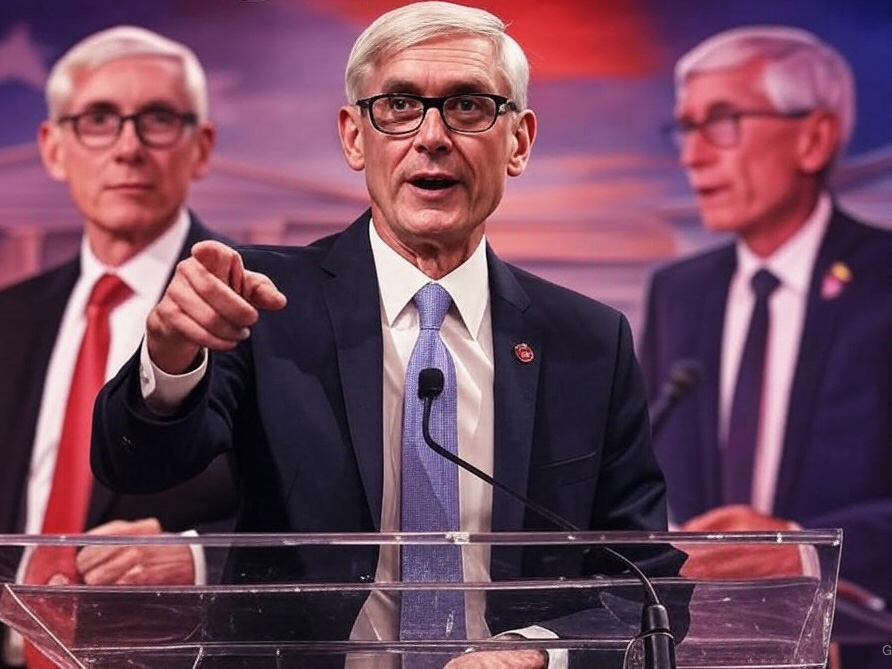Discover The Andy Parrish Show
The Andy Parrish Show

43 Episodes
Reverse
In this episode of The Andy Parrish Show: I’m Right – Deal With It, I dive into one of the most heated debates in American politics today: birthright citizenship. Many…
On New Year’s Day 2025, America witnessed two deadly attacks that our government and media want you to believe were completely unrelated. In New Orleans, a radicalized U.S. Army soldier…
In this episode of The Andy Parrish Show: I’m Right – Deal With It, I dive into one of the most heated debates in American politics today: birthright citizenship. Many conservatives—including myself at first—want to say: If you’re born here illegally, you’re not a citizen. But when I dig into the Constitution, the history of […]
Government Cover-Ups? The Truth About the New Year’s Attacks On the latest episode of I’m Right – Deal With It, I break down two New Year’s Day attacks that the government and media want you to believe are “unconnected.” Think about it. And yet—Washington and the press say there’s “no coordination.” That’s not just improbable. […]
In this episode of The Andy Parrish Show: I’m Right – Deal With It, I dig into the truth about the Ukraine war, the billions of dollars flowing overseas, and the political theater behind it all. The Media’s Half-Story Legacy media has chosen sides, turning “I stand with Ukraine” hashtags into virtue signaling while ignoring […]
The City of Onalaska has rolled out its 2025 budget proposals, and while I give them credit for transparency, the numbers reveal a troubling reality for taxpayers. On paper, officials say they’re keeping the mill rate flat. That sounds good—but here’s the catch: property values have been raised 28%. Since your taxes are tied to […]
On this episode of The Andy Parrish Show: I’m Right – Deal With It, I take apart the hysteria over tariffs and explain why they are not the boogeyman the left makes them out to be. Turn on the so-called “news” and you’d think tariffs mean the end of civilization. Politicians like Chuck Schumer run […]
The Fight Against Extremism at Columbia University: What You Need to Know
In a recently sat down with Ryan Mauro, a national security expert at the Capital Research Center, to discuss the growing extremist movement in America—particularly at Columbia University. What we uncovered is deeply disturbing.
Who Is Behind the Protests?
While the media portrays the unrest at Columbia as a simple student protest, Ryan’s research tells a different story. He has identified radical organizations, including Columbia University Apartheid Divest (CUAD) and Students for Justice in Palestine, as key players. These groups are not just advocating for Palestinian rights—they are openly supporting Hamas, promoting civil unrest, and calling for violence.
The Reality of the F1 Visa Loophole
One of the leaders of these movements, Mahmoud Khalil, is not even an American citizen. He entered the country on an F1 visa and was later granted permanent resident status. Many Americans don’t realize that permanent residency does NOT guarantee citizenship, and Khalil’s participation in these protests violates the conditions of his stay. Under the Immigration and Nationality Act, the U.S. has every right to deport individuals who express support for terrorist organizations.
Ilhan Omar’s Connection
Perhaps one of the most shocking revelations is that Rep. Ilhan Omar’s daughter was actively involved in organizing these radical protests. While the media attacks conservative figures for far less, Omar’s daughter’s participation has been conveniently ignored.
Why This Matters
If America is to remain strong, we must recognize that our enemies don’t need to invade with tanks and missiles. They are already here, using our own laws and freedoms to sow chaos. The protests at Columbia were not spontaneous; they were meticulously planned. They involved vandalism, property destruction, and even the unlawful detainment of janitorial staff. This is not a partisan issue—it’s a national security crisis.
What Can You Do?
Stay Informed – The mainstream media won’t cover this, so seek out trusted sources like Capital Research Center.
Speak Up – Share this information and let people know what’s happening.
Support Those on the Front Lines – People like Ryan Mauro are taking the heat for exposing the truth. Send them messages of encouragement and let them know you have their back.
“America isn’t just a piece of land—it’s the spirit of the people who fight to protect it. This is a fight worth having.” – Andy Parrish
What Is a Continuing Resolution?
A Continuing Resolution (CR) is Congress’s way of kicking the fiscal can down the road. Instead of passing an actual budget, they pass a short-term funding bill to keep the government running—often loaded with pork and unnecessary spending. The media and politicians use scare tactics, claiming that without a CR, the government will “shut down,” leaving grandma starving in the cold and soldiers without pay.
Except that’s not true.
The Truth About Government Shutdowns
If Congress doesn’t pass a budget or a CR, only discretionary spending is affected. Mandatory spending—which includes Social Security, Medicare, veteran benefits, and more—keeps flowing automatically. So no, grandma isn’t eating dog food, and our troops aren’t left stranded.
What shuts down?
Non-essential government programs
Some federal employees get furloughed
National parks and “symbolic” shutdown measures get rolled out to make it look worse than it is
Meanwhile, the real issue—out-of-control government spending—gets ignored.
Why CRs Are a Scam
Here’s why conservatives should always vote NO on continuing resolutions:
No accountability: Instead of debating a real budget, politicians jam funding bills full of waste and special interest projects.
Debt explosion: CRs continue funding at unsustainable Biden-era levels. Where’s the change we voted for?
Manipulation tactics: The fear-mongering around government shutdowns is designed to push weak-kneed Republicans into voting for more spending.
Backroom deals: CRs let politicians sneak in funding boosts (like FEMA’s massive increase) without scrutiny.
Trump Is Wrong on This One
As a huge Trump supporter, it pains me to say this: Trump is dead wrong for endorsing this CR. He’s attacking principled conservatives like Rep. Thomas Massie, one of the few people in Washington actually fighting for fiscal sanity.
We didn’t elect Trump to continue Biden-era spending levels. We elected him to cut spending and put America First. If Republicans in Congress had a spine, they’d pass a real budget instead of caving every few months.
The Bottom Line
CRs are designed to keep the spending machine rolling, not to serve the people.
Mandatory spending keeps going, so “government shutdown” fear-mongering is a lie.
If Republicans actually cared about fiscal responsibility, they’d pass a real budget and stick to it.
It’s time to wake up. If you hear someone pushing a CR, tell them: “Nope. That’s not a budget. That’s a scam.”
🔹 Follow me on X @andyparrish for more unfiltered truth🔹 Subscribe to my podcast for more hard-hitting analysis
And remember: I’m right. Deal with it.
The war in Ukraine isn’t as simple as the media makes it out to be. While social media warriors change their profile pictures and politicians throw billions of taxpayer dollars at the conflict, few are asking the real questions. Why is the U.S. so invested in Ukraine? What are the economic and strategic interests at play? And why does President Zelensky act more like a Hollywood PR expert than a wartime leader? In this post, we break down the history, the stakes, and the uncomfortable truths about America’s involvement in Ukraine.
Tony Evers’ Gender-Neutral Agenda: The Lie He Hoped You’d Ignore
Governor Tony Evers recently came under fire for altering legal language in Wisconsin to remove traditional family terms like “mother” and “father” in favor of gender-neutral terminology, including the controversial replacement of “mother” with “inseminated person.” Evers has claimed that this is about ensuring legal clarity for parents using in vitro fertilization (IVF), but the truth is far different.
The Legislative Process & the Lie
Under Wisconsin Statute § 16.47, the governor is required to submit a biennial budget proposal to the Joint Finance Committee (JFC), which consists of 16 legislative members. This proposal is subject to amendments and must pass both legislative chambers in identical form before it becomes law. After passage, the Legislative Reference Bureau (LRB) finalizes language and oversees implementation.
Evers, however, misrepresented his role in this process. He claimed that the decision to alter these gendered terms was a necessary legal update to accommodate IVF services. However, IVF-related protections have long been covered under existing state and federal law, including the Family and Medical Leave Act (FMLA) and Wisconsin Statute § 103.10, which already grant leave and protections to individuals who give birth—regardless of how they conceive.
Reading the Signs: Body Language & Deception
When confronted about the changes, Evers displayed classic signs of deception:
Head Down Before Answering – A defensive posture, indicating discomfort.
Glancing Down and to the Right – This signals emotional justification rather than factual recall.
Direct Eye Contact on Attacks – A technique used to project confidence while evading accountability.
His response was not one of transparency but rather a “block and bridge” strategy—dodging the question and redirecting attention to a strawman argument about Republicans allegedly opposing IVF, which is false.
The Bottom Line
Evers didn’t just tweak some wording—he intentionally manipulated the law to conform to a radical ideological agenda while misleading Wisconsinites about the reasoning. The media failed to challenge him, but the facts are clear: his changes were unnecessary, his justification was false, and his deception was obvious.
Wisconsin voters deserve better than a governor who plays word games with the law while gaslighting the public.
In a shocking attempt to push gender-neutral language, Wisconsin Governor Tony Evers’ budget proposal sought to replace biological terms such as “mother” and “father” with “inseminated person” and “spouse.” This move sparked outrage among conservatives who see it as yet another effort to erase traditional family values.
What Did Evers’ Budget Attempt to Change?
Evers’ proposed changes included:
Replacing mother with inseminated person
Replacing father with spouse
Changing husband and wife to spouse
Changing stepmom and stepdad to stepparent
The justification? According to Evers, it was meant to ensure “legal certainty” for individuals undergoing IVF (in vitro fertilization). However, no other state requires this kind of language shift to guarantee IVF rights, making Evers’ rationale highly questionable.
Breaking Down Evers’ Weak Defense
When asked about the changes, Evers immediately looked down—classic defensive body language. As Andy Parrish explains in the latest episode of I’m Right, Deal With It, looking down and to the right typically indicates an emotional argument rather than a factual one.
Throughout the exchange, Evers repeatedly asserted that the change was to “help moms,” yet failed to explain how removing the word “mother” actually benefits women. Moreover, the bill also altered terms like husband and wife, which have nothing to do with maternal healthcare.
Who Asked for This?
One glaring issue: No major group had publicly requested these changes. The Wisconsin budget process involves submission to the Joint Finance Committee, where amendments are made before being voted on by the state legislature. So, when Evers claims “all we want”, the question remains—who exactly is we?
The Bigger Picture
This move is part of a broader trend by progressive politicians to erase biological realities in favor of so-called inclusivity. However, inclusivity should not come at the cost of erasing universally understood and respected terms like mother and father.
If Wisconsin Democrats truly wanted to help parents, they could focus on expanding parental leave policies or improving childcare affordability—rather than engaging in ideological wordplay.
Final Thoughts
The bottom line? No one needed or asked for this change. It’s a blatant attempt to push an agenda that most Wisconsinites do not support. Governor Evers should be focusing on real issues facing Wisconsin families instead of attempting to redefine biological terms for political gain.
Cringe-worthy land acknowledgments are everywhere, but let’s be real—America wasn’t stolen, it was settled, fought for, and built by hardworking Americans. So why haven’t the woke crowd given their land back? Because it’s never been about justice—it’s about control. Let’s break it down.
The Real Story Behind Trump’s Tariff Strategy: Why Mexico and Canada Depend on Us
When Donald Trump reintroduced tariffs on North American trade partners, critics predicted disaster: skyrocketing prices, international outrage, and economic turmoil. But reality paints a different picture — one in which tariffs are a powerful tool to protect American industry, secure borders, and assert economic leadership.
Tariffs vs. Taxes: Understanding the Difference
A critical distinction must be made between tariffs and taxes. Taxes burden American families and businesses, often discouraging economic growth. Tariffs, however, are targeted economic tools designed to correct trade imbalances and encourage fair trade practices.
Before the implementation of NAFTA in 1994, the United States maintained a $1.6 billion trade surplus with Mexico. By 2020, this had turned into a $101 billion trade deficit, as American manufacturing jobs moved south due to cheaper labor and fewer regulations. The same trend was seen with Canada, where the U.S. now faces a $21 billion goods trade deficit despite our critical role in refining Canadian oil.
Our Leverage: Exporting Necessities
Mexico and Canada are far more reliant on the United States than we are on them:
Mexico exports 80% of its goods to the U.S.
Canada sends 75% of its exports to the U.S.
What do we send them in return? The list reads like a survival kit for modern economies:
Pharmaceuticals: Essential medications and medical equipment.
Refined Oil: Mexico depends heavily on the U.S. for its gasoline supply.
Semiconductors and Technology: Critical components for electronics and modern infrastructure.
If these nations retaliated with tariffs, they would only cripple their economies, as they have limited alternatives for sourcing these necessities.
Trade Alternatives: America’s Freedom to Source Elsewhere
Unlike Mexico and Canada, the United States has abundant options for sourcing goods:
Electronics from Taiwan and South Korea
Textiles from Vietnam
Automotive components from Europe
Agricultural products from South America
This flexibility underscores America’s strength in global trade negotiations.
Economic Wars of the Future
As Trump correctly identified, future conflicts won’t be fought with traditional weapons but through economic leverage and societal unrest. By using tariffs strategically, America can maintain its dominance while safeguarding jobs and industries at home.
Conclusion
Far from being a reckless gamble, tariffs are a calculated move to protect American interests. With Mexico and Canada heavily dependent on the U.S. market, we hold the upper hand. It’s time to use that leverage to ensure a prosperous and secure future for American workers.
Tariffs often evoke intense political debate, but their role in economic diplomacy is crucial. Tariffs are not taxes, as some would have you believe. Instead, they are tools designed to promote fair trade and protect national interests. While not universally effective, tariffs can provide leverage in trade relationships, particularly with neighboring countries like Mexico and Canada.
Under the North American Free Trade Agreement (NAFTA), tariffs between these nations were largely eliminated. However, this led to a significant shift in U.S. manufacturing to Mexico, where labor was cheaper, and regulations were less stringent. The result? A weakened American industrial base and an outsized reliance by Mexico and Canada on U.S. consumption.
Currently, 80% of Mexico’s exports and 75% of Canada’s exports are purchased by the United States. This dependency underscores why tariffs can be a powerful economic tool. If the U.S. imposes tariffs, these nations face severe economic repercussions, as their economies are heavily tied to American purchasing power.
Moreover, retaliatory tariffs from these nations would have limited impact on the U.S. economy, as only 15% of American exports are sold to Mexico and Canada combined. The U.S. also holds strategic advantages in sectors like technology, pharmaceuticals, and refined oil—essential goods that are difficult for other nations to source elsewhere.
In contrast, raising income taxes domestically, as some political figures advocate, directly impacts American families and businesses, reducing disposable income and stifling economic growth. Unlike tariffs, which target foreign trade practices, income taxes burden the American taxpayer without providing a mechanism for economic diplomacy.
Economic security is national security. Tariffs can be an effective means of safeguarding jobs and ensuring that trade relationships remain balanced and fair. As debates continue, it is essential to understand the strategic value of these measures in maintaining America’s economic strength.
The recent collision between a Black Hawk helicopter and a commercial airliner near Washington, D.C., has sent shockwaves through the aviation community and beyond. This tragic event, resulting in the loss of numerous lives, raises serious questions about the safety of our skies, particularly in high-traffic, restricted airspaces like that around the nation’s capital. On a recent episode of The Andy Parrish Show: I’m Right – Deal with It!, I spoke with Colonel Big Joe, a highly experienced Marine pilot, to unpack the complexities of this incident and delve into some of the critical factors that may have contributed to it.
The DC Airspace: A Highly Regulated Zone
The airspace around Washington, D.C., is one of the most heavily regulated in the United States. Since 9/11, the FAA has implemented an Air Defense Identification Zone (ADIZ), which requires specific qualifications, training, and communication protocols for all aircraft operating within it. Pilots must be meticulous about who they talk to and the codes they use on their transponders. Failure to comply can result in flight violations, potentially leading to being intercepted and even forced to land.
Helicopter Training and Night Vision
Military helicopters, such as the Black Hawk involved in the collision, frequently operate in the DC area for training and transport. These flights, often conducted at low levels along the Potomac River, serve to maintain pilot proficiency with navigation, checkpoints, and obstacles. Many of these training flights are done at night, often using night vision goggles (NVGs). While NVGs enhance visibility in the dark, they also present challenges, notably the loss of depth perception. Pilots must train to compensate for this limitation, scanning and moving their heads constantly to create a sense of depth.
The Unpredictable Nature of Flight
The seemingly improbable nature of this collision is worth examining. I asked mathematicians and AIs to calculate the odds of a collision between a Black Hawk and a commercial airliner, and all returned with the same answer – that it was not probable. Colonel Big Joe compared the situation to a complicated math word problem, noting how even the slightest change in conditions, such as a small change in speed or direction, can lead to unforeseen outcomes.
Technological Limitations and Human Factors
Both commercial airliners and military aircraft are equipped with various technologies intended to enhance safety, but these are not foolproof. Commercial airliners use ADS-B technology to track aircraft. However, there can be a significant time delay in the information displayed on screens, sometimes by as much as 30 seconds, or a mile to a mile and a half. This delay can be critical in situations where aircraft are moving at high speeds. Additionally, while low altitude warning systems are present in some aircraft, there is not always a system to warn of an aircraft coming directly at you.
The investigation into the collision will thoroughly examine the human factors involved. Investigators will scrutinize the pilots’ personal lives, including any potential stressors like divorce, substance use, or medications. Air traffic controller recordings and flight data will also be examined to determine whether there were any errors in communication or instructions.
Lessons from the Past
Colonel Big Joe recounted a previous incident in the mid-90s where two Marine helicopters collided during night vision goggle training. This underscores the risks inherent in complex training missions, even with experienced pilots. We also discussed the “Miracle on the Hudson,” where Captain Sully Sullenberger’s experience and instinct led to a successful water landing despite the checklist telling him to try for the airport. Checklists are good, but experience is better, and pilots are rigorously trained for these kinds of situations.
The collision of the Black Ha
Let’s cut through the noise and get straight to the facts. Birthright citizenship, the notion that any child born on U.S. soil automatically becomes an American citizen, has been the subject of heated debate, especially in the context of immigration. But the truth of the matter? It’s not as simple as people make it out to be.
Born from the 14th Amendment of the U.S. Constitution, birthright citizenship is rooted in a post-Civil War effort to guarantee equal protection under the law. But does it still hold the same weight today? Is it truly the right we think it is, or has it morphed into a tool of political exploitation?
The 14th Amendment: A Glimpse Into History
The 14th Amendment, passed in 1868, was intended to ensure that newly freed slaves had the same rights as all Americans. The amendment is clear: “All persons born or naturalized in the United States, and subject to the jurisdiction thereof, are citizens of the United States and of the State wherein they reside.” Simple enough, right?
But let’s break it down. The key phrase here is “subject to the jurisdiction thereof.” And this is where a lot of folks get it wrong. It wasn’t a blanket provision to allow anyone who sets foot on American soil to claim citizenship. In fact, the language was meant to exclude certain people, like the children of foreign diplomats and enemy combatants, who were not subject to U.S. jurisdiction.
The Dred Scott Decision: A Precursor to the 14th Amendment
Before we dive into the modern debates, let’s take a quick trip back to the Dred Scott decision of 1857. The U.S. Supreme Court ruled that African Americans, whether free or enslaved, could not be U.S. citizens. That decision, grounded in racism, was one of the key catalysts for the 14th Amendment’s passage, designed to ensure citizenship for all Americans—especially former slaves.
So, when people argue that the 14th Amendment is some kind of blanket approval for anyone born here to become a citizen, they’re missing the point. The original intent was to ensure that all people, regardless of race, were treated equally under the law. It wasn’t about opening the floodgates for illegal immigration.
The Birthright Citizenship Debate: Is It Time for Change?
In recent years, birthright citizenship has come under fire, with some arguing that it’s been abused by illegal immigrants who use it as a loophole to anchor their children to the U.S. While the law is clear about who qualifies for citizenship, the practice has become a contentious issue—especially when it comes to “anchor babies,” children born in the U.S. to undocumented parents who use their child’s citizenship to gain entry or stay in the country.
Here’s where we need to ask ourselves: What does it mean to be American? If we open the doors to automatic citizenship based on birthright alone, do we risk cheapening the value of citizenship itself? The law was never meant to create a system where people can exploit our borders for gain, and that’s something we need to take seriously as we reevaluate this policy.
Immigration and the Trump Administration
It’s impossible to talk about birthright citizenship without bringing up President Trump’s attempt to address the issue through executive action. His administration aimed to curb the practice, arguing that the 14th Amendment didn’t automatically guarantee citizenship to the children of undocumented immigrants.
While the debate is far from settled, one thing is clear: The issue of birthright citizenship goes beyond political theater. It’s about the future of this country, the integrity of our laws, and what it truly means to be an American.
Conclusion: Let’s Honor the Intent of the Constitution
It’s time we stop letting the debate over birthright citizenship devolve into sensationalized soundbites. The 14th Amendment was a monumental step toward equality, and it’s important that we honor its original intent. But, that doesn’t mean we shouldn’t have a di
Birthright Citizenship!
If you’re born on U.S. soil, congratulations—you’re a U.S. citizen.
The 14th Amendment was a direct response to reject the Supreme Court’s infamous Dred Scott decision. The Court ruled that a man born into slavery couldn’t be a citizen because his mother was a slave. The Court also ruled that enslaved people and their descendants could never be U.S. citizens.
The 14th Amendment erased this injustice: if you’re born here, you’re a citizen, regardless of your family’s background or your parent’s status.
But let’s be clear: a child’s citizenship doesn’t “magically” extend to their parents. If parents are here illegally, they’re not entitled to citizenship.
We have laws for a reason, and breaking them has consequences, including deportation. If deportation separates families, that’s on the parent who chose to break the law, not on the United States for enforcing it. Respect for the rule of law is what keeps our society functional, fair, and free.I’m Andy Parrish for WIZM.
As I see it, I’m Andy Parrish. The La Crosse County Board has been asked to approve a $250,000“grant” for the La Crosse Airport. Why? The funds would go towards a $1.5 million, what they call a “minimum revenue guarantee program”, which I call corporate welfare, aimed at bringing DeltaAirlines back to the region. Now, to be fair, I applaud the board for listening to their constituents. And thankfully, the board has not yet made a decision on this request. But let me be clear. There is no justification for taking money from hardworking individuals and local businesses to guarantee revenue for a private company. Corporate welfare should never take precedence over offering relief to taxpayers who are already burdened by sky-high taxes. If the board can find $250,000 to guarantee Delta’s revenue,they should have already cut your taxes by the same. For WIZM, I’m Andy Parrish.
Bye TikTok: America’s Stand Against Digital Espionage
In a move that’s been years in the making, America is finally banning TikTok—a decision that’s not just about an app but about the very fabric of our national security. TikTok isn’t just a harmless platform for dance videos and viral trends; it’s a meticulously crafted tool for data collection, internal division, and digital warfare, all serving the strategic goals of the Chinese government.
A History of Digital Warfare
Warfare has evolved. Gone are the days of muskets and battle lines, and even the era of tanks and aerial bombings feels outdated. Modern warfare is about data, influence, and internal disruption. TikTok exemplifies this shift, operating as a digital battlefield where the real weapon is information.
Since 2017, when China passed its National Intelligence Law, every Chinese entity, including ByteDance (TikTok’s parent company), has been obligated to share data with the government upon request. This includes user activity, location data, and even what floor of a building you work on. Think about that: your phone, with TikTok installed, becomes a tool for mapping critical infrastructure for a foreign government.
How TikTok Divides Us
Perhaps even more dangerous than data theft is TikTok’s role in fueling internal conflict. By promoting divisive content and amplifying cultural flashpoints, the app subtly erodes the social fabric of America. As Andy Parrish pointed out in his latest podcast episode, the damage caused by riots linked to political and social unrest in recent years is staggering. And yet, many of these events were fueled, organized, and magnified through platforms like TikTok.
Why China Doesn’t Allow TikTok
Here’s a telling detail: China itself restricts TikTok. While the app flourishes abroad, the version available in China, Douyin, operates under strict government oversight with limited content. Why? Because the Chinese government knows its potential to destabilize societies and would rather not risk the same outcomes domestically.
The Economic and Security Threat
The TikTok ban is not about suppressing free speech or creativity. It’s about protecting Americans from a government that has demonstrated its willingness to exploit every avenue of vulnerability. From collecting personal data to manipulating social narratives, TikTok is the tip of the iceberg in China’s broader strategy of undermining global competitors like the United States.
What’s Next?
As the ban takes effect, skeptics will argue about VPNs and workarounds, but the reality is clear: America cannot afford to compromise its security for fleeting digital trends. The free market will undoubtedly fill the void left by TikTok with safer alternatives, but for now, this ban is a critical step in safeguarding our nation.
Let’s not be naive about what’s at stake. TikTok isn’t the product; you are the product. And the sooner we stop feeding into this global surveillance machine, the better off we’ll be.
Adios, TikTok. It’s time to reclaim our digital sovereignty.
Comments
 United States
United States






















